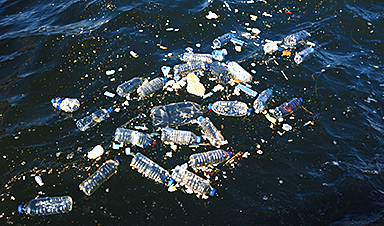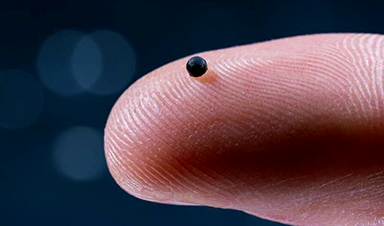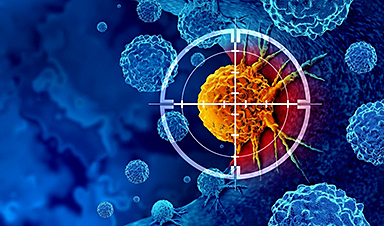Researchers at the Weizmann Institute have developed a biodegradable composite material that could play a significant role in addressing the global plastic waste crisis.
Billions of tons of plastic waste clutter our planet. Most of it accumulates on land, settles in the oceans, or disintegrates into tiny particles called microplastics, which pollute the air and water, infiltrating vegetation as well as the bloodstreams of humans and animals. The threat posed by plastics intensifies each year, as they are composed of massive molecules called polymers that resist biodegradation. Currently, biodegradable plastics account for less than one-fifth of total plastic production, and the processes required to break them down remain relatively cumbersome.
In a study published in ACS Nano, Dr. Angelica Niazov-Elkan, Dr. Haim Weissman and Prof. Boris Rybtchinski of the Molecular Chemistry and Materials Science Department at the Weizmann Institute of Science have created a new composite plastic that degrades easily using bacteria. This new material, produced by combining a biodegradable polymer with crystals from a biological substance, has three major benefits: It is cheap, easy to prepare, and very strong. Also participating in the study were the late Dr. Eyal Shimoni, Dr. XiaoMeng Sui, Dr. Yishay Feldman, and Prof. H. Daniel Wagner.
Currently, many industries are enthusiastically adopting composite plastics, which are made by combining two or more pure materials and possess the various beneficial properties such as lightness and strength. These plastics now serve to manufacture key parts of a wide variety of industrial products, from airplanes and cars to bicycles.
The Rise of Composite Plastics
Seeking to create a composite plastic that would meet the needs of industry while also being environmentally friendly, the Weizmann researchers decided to focus on commonplace, inexpensive source materials whose properties could be improved. They found that molecules of tyrosine – a prevalent amino acid that forms exceptionally strong nanocrystals – could be used as an effective component in a biodegradable composite plastic. After examining how tyrosine combines with several types of polymers, they chose hydroxyethyl cellulose, a derivative of cellulose, which is employed extensively in the manufacture of medicines and cosmetics.
On its own, hydroxyethyl cellulose is a weak material that disintegrates readily. To combine it with tyrosine, the two materials were mixed together in boiling water. When they cooled and dried, an exceptionally strong composite plastic was formed, made of fiber-like tyrosine nanocrystals that grew into the hydroxyethyl cellulose and integrated with it. In one experiment that revealed the new plastic's strength, a 0.04-millimeter-thick strip of the material withstood a load of 6 kilograms.
Moreover, the team discovered that the new material had several other unique characteristics, making it even more useful for industry. Usually, when a material is strengthened, it loses plasticity.
Unique Properties and Industrial Potential
This new composite plastic, however, in addition to being very strong, is also more ductile (malleable) than its core component, hydroxyethyl cellulose. In other words, combining the two materials created a synergy that manifests itself in the emergence of extraordinary properties and, consequently, has massive industrial potential.
Since both cellulose and tyrosine – the crystals of which can be found in various types of hard cheese – are edible, the biodegradable composite plastic can actually be eaten. Is it also tasty? We will have to wait to find out: Since the production process in the lab is not hygienic enough for foodstuffs, the researchers are yet to have a nibble.
Rybtchinski sums up: "The follow-up study that we have already started could advance the commercial potential of this new material, since we have replaced the boiling in water with melting, as is more common in industry. This means that we heat up the biodegradable polymers until they become liquid and then mix in the tyrosine or other suitable materials. If we manage to overcome the scientific and technical challenges involved in this process, we will be able to explore the possibility of producing this new composite plastic on an industrial scale."
Reference: "Emergent Self-Assembly of Sustainable Plastics Based on Amino Acid Nanocrystals" by Angelica Niazov-Elkan, Haim Weissman, Eyal Shimoni, XiaoMeng Sui, Yishay Feldman, H. Daniel Wagner and Boris Rybtchinski, 23 October 2023, ACS Nano.
DOI: 10.1021/acsnano.3c02528
Prof. Boris Rybtchinski's research is supported by the Tom and Mary Beck Center for Advanced and Intelligent Materials and the Wolfson Family Charitable Trust & the Wolfson Foundation.
News
Novel mRNA therapy curbs antibiotic-resistant infections in preclinical lung models
Researchers at the Icahn School of Medicine at Mount Sinai and collaborators have reported early success with a novel mRNA-based therapy designed to combat antibiotic-resistant bacteria. The findings, published in Nature Biotechnology, show that in [...]
New skin-permeable polymer delivers insulin without needles
A breakthrough zwitterionic polymer slips through the skin’s toughest barriers, carrying insulin deep into tissue and normalizing blood sugar, offering patients a painless alternative to daily injections. A recent study published in the journal Nature examines [...]
Multifunctional Nanogels: A Breakthrough in Antibacterial Strategies
Antibiotic resistance is a growing concern - from human health to crop survival. A new study successfully uses nanogels to target and almost entirely inhibit the bacteria P. Aeruginosa. Recently published in Angewandte Chemie, the study [...]
Nanoflowers rejuvenate old and damaged human cells by replacing their mitochondria
Biomedical researchers at Texas A&M University may have discovered a way to stop or even reverse the decline of cellular energy production—a finding that could have revolutionary effects across medicine. Dr. Akhilesh K. Gaharwar [...]
The Stunning New Push to Protect the Invisible 99% of Life
Scientists worldwide have joined forces to build the first-ever roadmap for conserving Earth’s vast invisible majority—microbes. Their new IUCN Specialist Group reframes conservation by elevating microbial life to the same urgency as plants and [...]
Scientists Find a Way to Help the Brain Clear Alzheimer’s Plaques Naturally
Scientists have discovered that the brain may have a built-in way to fight Alzheimer’s. By activating a protein called Sox9, researchers were able to switch on star-shaped brain cells known as astrocytes and turn them into [...]
Vision can be rebooted in adults with amblyopia, study suggests
Temporarily anesthetizing the retina briefly reverts the activity of the visual system to that observed in early development and enables growth of responses to the amblyopic eye, new research shows. In the common vision [...]
Ultrasound-activated Nanoparticles Kill Liver Cancer and Activate Immune System
A new ultrasound-guided nanotherapy wipes out liver tumors while training the immune system to keep them from coming back. The study, published in Nano Today, introduces a biodegradable nanoparticle system that combines sonodynamic therapy and cell [...]
Magnetic nanoparticles that successfully navigate complex blood vessels may be ready for clinical trials
Every year, 12 million people worldwide suffer a stroke; many die or are permanently impaired. Currently, drugs are administered to dissolve the thrombus that blocks the blood vessel. These drugs spread throughout the entire [...]
Reviving Exhausted T Cells Sparks Powerful Cancer Tumor Elimination
Scientists have discovered how tumors secretly drain the energy from T cells—the immune system’s main cancer fighters—and how blocking that process can bring them back to life. The team found that cancer cells use [...]
Very low LDL-cholesterol correlates to fewer heart problems after stroke
Brigham and Women's Hospital's TIMI Study Group reports that in patients with prior ischemic stroke, very low achieved LDL-cholesterol correlated with fewer major adverse cardiovascular events and fewer recurrent strokes, without an apparent increase [...]
“Great Unified Microscope” Reveals Hidden Micro and Nano Worlds Inside Living Cells
University of Tokyo researchers have created a powerful new microscope that captures both forward- and back-scattered light at once, letting scientists see everything from large cell structures to tiny nanoscale particles in a single shot. Researchers [...]
Breakthrough Alzheimer’s Drug Has a Hidden Problem
Researchers in Japan found that although the Alzheimer’s drug lecanemab successfully removes amyloid plaques from the brain, it does not restore the brain’s waste-clearing system within the first few months of treatment. The study suggests that [...]
Concerning New Research Reveals Colon Cancer Is Skyrocketing in Adults Under 50
Colorectal cancer is striking younger adults at alarming rates, driven by lifestyle and genetic factors. Colorectal cancer (CRC) develops when abnormal cells grow uncontrollably in the colon or rectum, forming tumors that can eventually [...]
Scientists Discover a Natural, Non-Addictive Way To Block Pain That Could Replace Opioids
Scientists have discovered that the body can naturally dull pain through its own localized “benzodiazepine-like” peptides. A groundbreaking study led by a University of Leeds scientist has unveiled new insights into how the body manages pain, [...]
GLP-1 Drugs Like Ozempic Work, but New Research Reveals a Major Catch
Three new Cochrane reviews find evidence that GLP-1 drugs lead to clinically meaningful weight loss, though industry-funded studies raise concerns. Three new reviews from Cochrane have found that GLP-1 medications can lead to significant [...]





















